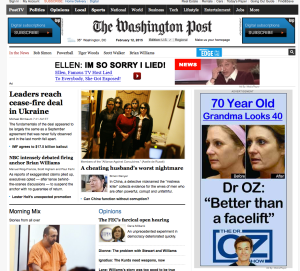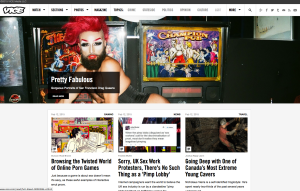A Group Effort By: Emily Vignone, Hannah-Catherine Smith, and Courtney Such
Is this site journalism? Why or why not? Is it both, if so how? Show and give examples
 Vice is a mixture of journalism and “fluff.” The news section has flashy headlines, yet pretty in-depth reporting. One story posted today discusses flight attendants’ experiences with human trafficking and what the new protocols in place look like. Although only one person was clearly identified as an original source to Vice, reporter Mary Emily O’Hara does a thorough job covering as many corners of the story as she can — from court records and Department of Homeland Security updates to quoting a DHS spokesman, they do their digging. O’Hara has a background full of journalistic experience, too, including writing for a Pulitzer Prize winning publication — but it’s important to note that a majority of their writers are freelancers. Vice has many other arenas than news, though, including entertainment, sports, and even their own YouTube channel for original episodes.
Vice is a mixture of journalism and “fluff.” The news section has flashy headlines, yet pretty in-depth reporting. One story posted today discusses flight attendants’ experiences with human trafficking and what the new protocols in place look like. Although only one person was clearly identified as an original source to Vice, reporter Mary Emily O’Hara does a thorough job covering as many corners of the story as she can — from court records and Department of Homeland Security updates to quoting a DHS spokesman, they do their digging. O’Hara has a background full of journalistic experience, too, including writing for a Pulitzer Prize winning publication — but it’s important to note that a majority of their writers are freelancers. Vice has many other arenas than news, though, including entertainment, sports, and even their own YouTube channel for original episodes.
 Washington Post is one of the oldest examples of classic journalism, even though they have a liberal approach. This site is a one-stop place for trained and experienced journalists, and you don’t need to read through many stories to come to this conclusion (if you agree with what they say).
Washington Post is one of the oldest examples of classic journalism, even though they have a liberal approach. This site is a one-stop place for trained and experienced journalists, and you don’t need to read through many stories to come to this conclusion (if you agree with what they say).
How does the site incorporate “citizen journalism”, social commentary or input, or sources pulled by average citizens?
Vice allows anyone to submit tips or suggestions on what they should report on next. While some news sources keep company email addresses to themselves, their entire “About” page is dedicated to inviting others to contribute ideas to their content database.

Washington Post (interestingly enough) also provides employee information for tips. Although they provide their email addresses, I don’t think they would be as willing to take advice from their readers. Their Twitter account is probably their preferred platform for starting a conversation with audience members — the bio reads, “Tweets about everything from breaking news to bad restaurants. Sometimes global, sometimes local.”
How does the site source its info? What type of sources do they use & how are sources incorporated in the reports?
Vice tags information at the bottom of each page, citing department websites or inspirations for the story they are working on. Washington Post cites sources that further support or provide more information on what they are originally reporting.
What is the writing style? Is it straightforward? Dry? Poetic? Long-form? Etc.
Vice takes two approaches in their writing, one for news and one for entertainment. Their news form writing is professional, straightforward, and informative. Whereas their stories used to entertain have a sarcastic, almost darker sense of humor. Each writer seems to take a different approach in their style of writing but the overall theme is that there are two approaches in their writing, news and entertainment.
The writing style of the Washington Post is very formal and can be informative dependent on your political party. It has the traditional feel of newspaper journalism.
How does the site establish credibility of both the brand and reporters?

I don’t know how credible I find Vice to be. Prior to this assignment, I had never heard of the site and after browsing it for some time I couldn’t say that I felt comfortable identifying it as a credible. It seems to be a random assortment of articles, that are entertaining, yet not very credible. The site links all of the Twitter handles of their writers and each one I researched said they were freelance writer.
The Washington Post begins to lose credibility dependent on your political party. It has a reputation for being very biased and left wing. The information is tailored for democrats, writing stories about social, political, and economic causes to attract the liberal.
How does the site make money? Where/how are ads used? Who advertises?
Vice primarily employs ads of its own brand like Vice Sports. However, we noticed one re-occuring ad for Altitude Drop that does not seem to be part of the company used as both a banner ad and a sidebar ad. They also have pop-up ads at random for Audi.
The Post’s website is covered in sidebar advertisements, which is a major source of revenue. They are for online shopping websites and other miscellaneous companies.
How often is the site updated?
Both are edited every day, multiple times a day
How is multimedia used? Visuals? Graphics? How are stories packaged? Is it entertaining?

Vice is brilliantly edited using video, photographs with a certain “look,” graphics, and eye catching and provocative headlines. The graphics are clean and modern and the photos have an eerie, progressive feel. I was incredibly entertained surfing through the site for the first time because the site is not afraid to get in your face and address the controversial.
The Washington Post employs the use of classic journalism images in a digital format. However, they are not overly distracting and focus mainly on the text of the stories.
Favorite things about the site? Least favorite?
I loved the images in Vice. The photography and media used is very contemporary. I also really liked the humor used in the social/cultural/entertainment articles. The site had some pretty funny articles! I did not like that the crude often outweighed the message. I think there is a fine line between good humor and distraction. There was also a lot going on. I had a lot of trouble focusing on one article because so many caught my eye. This is good on their end, but it definitely reinforces the idea of skimming for information rather than completely absorbing it.
I like that the Washington Post brings traditional news to a digital platform. However, I do not like how they present news in such a biased platform. It takes away from the ethos of the journalists and print company because if you do not agree with their political partisanship, then you will not believe their stories.
SOURCES// Vice; The Washington Post

Leave a comment